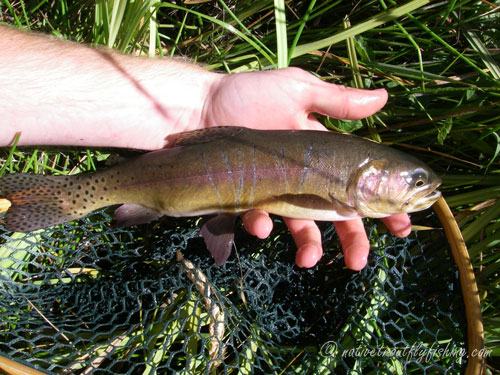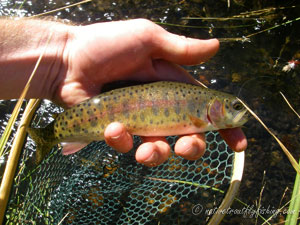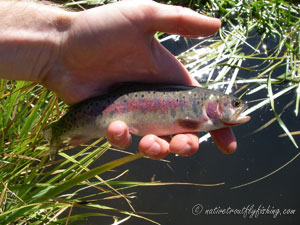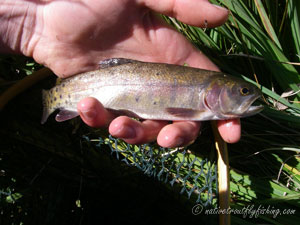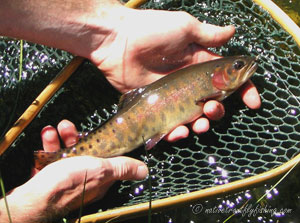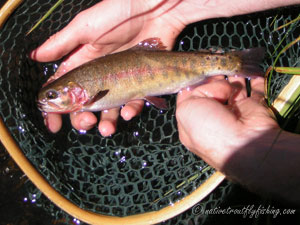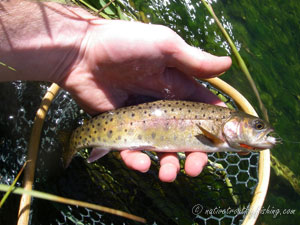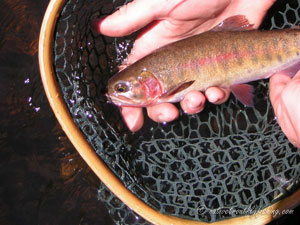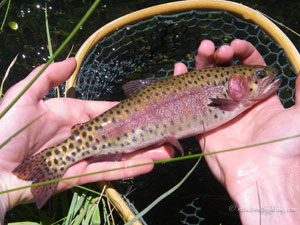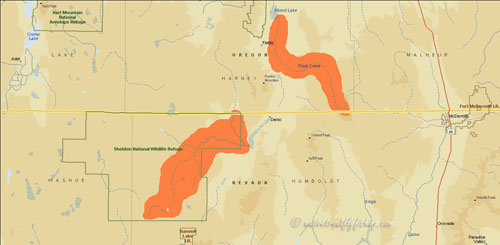Alvord Cutthroat
Oncorhynchus henshawi alvordensis
A fish matching the description of the Alvord Cutthroat from a small stream in southern Oregon.
Introduction
The Alvord Cutthroat Trout is one of the two subspecies of Cutthroat that have been officially declared extinct. These fish were native to two small streams, Trout and Virgin Creek, which drain to the arid Alvord basin of Oregon and Nevada and there is also some evidence that they were historically native to at least some of the streams draining the Steens and Pueblo Mountains as well However, when Rainbow Trout were introduced into the streams, both populations went extinct in short order. In the 1980’s, a small population of Alvord Cutthroat was rediscovered in an isolated portion of Virgin Creek, Nevada, but unfortunately by the time that the fish had been rediscovered a reservoir upstream, which contained Rainbow Trout had overflowed just a few years prior and all of the youngest fish remaining were hybridized. Twenty-five of the old most phenotypical Alvord fish from the creek were transplanted into another stream, however that effort failed to produce a population and the Alvord Cutthroat slipped into extinction again. However, once again there is the question of if the Alvord is extinct or not and phenotypical Alvord Cutthroat Trout may still swim in one small stream in southeastern Oregon. There is also the question of whether or not the transplant of the Virgin Creek fish was more successful than it first appeared as fish expressing the Alvord Cutthroat phenotype have been found in the Jackson Creek in recent years.
Life History Information
Little is known about the life history of Alvord Cutthroat, as no studies were conducted prior to their extinction within their native range. The Alvord Cutthroat were adapted to an adfluvial life history, but with the drying of ancient Lake Alvord they would have been restricted to stream resident or potentially fluvial life histories and are thought to have had a similar life history to stream dwelling Cutthroat in the Willow-Whitehorse or Lahontan basins. The original 1934 collections of Alvord Cutthroat by Carl Hubbs in Virgin Creek prior to hybridization with Rainbow Trout had an average size of 4 to 7 inches (10 to 18 cm) and likely represented juveniles. When the Alvord Cutthroat was rediscovered Virgin Creek in the 1980’s, some of the fish caught in the deeper pools measured almost 20 inches (50 cm) (Smith 1995; Behnke 2002). This would be a respectable size in any stream, but this part of Virgin Creek is only three feet (1 meter) across in most places. Similarly, one of the streams that hosts putative Alvord phenotypes today is less than two feet (0.6 m) across in most places, but I caught a fish that was approximately 15 inches (38 cm) in one of the pools in 2008. Like other stream resident trout, it is thought that aquatic and terrestrial insects made up most of the Alvord’s diet, which also appears to be the case for the remaining stream resident putative Alvord phenotypes today. However, given the size of the 1980’s fish, they may have been piscivorous in their native streams as well, potentially feeding on juvenile Cutthroat or the Alvord Chub, which co-occur in Trout and Virgin Creeks. Based on the 1980’s Virgin Creek fish, the maximum lifespan of these trout was thought to be about seven years. Like other Cutthroat, the Alvord was a spring spawning fish, which made susceptible them to hybridization and replacement by introduced Rainbow Trout.
Status
While the Alvord Cutthroat one of the two Cutthroat subspecies considered extinct, there is still some question whether it has been completely lost. If the Alvord Cutthroat is still around its continued existence is quite precarious, which is in keeping with the tragic too little and too late story of the Alvord Cutthroat. This story dates back to their discovery in 1934 in Trout Creek, Oregon and Virgin Creek, Nevada. When the Alvord Cutthroat was first described by Carl L. Hubbs in 1934, hybridization with Rainbow Trout stocked in 1929 was already apparent in Trout Creek (Hubbs and Miller 1948, Williams and Bond 1983). In 1933, Rainbow Trout were planted in Virgin Creek and by the 1970’s when the streams were sampled for Cutthroat only Rainbow Trout could be detected (Behnke 1979; 1992). For fifty years, the Alvord Cutthroat was considered to be extinct, until in the 1980's when Nevada Department of Wildlife (NDOW) crews found several Cutthroat in a canyon section above a rockslide on Virgin Creek. However, when a native trout enthusiast Robert Smith visited the creek, he primarily found Rainbow Trout and Rainbow x Cutthroat hybrids, although he did catch several large fish that accurately matched the Alvord Cutthroat description, including one that was close to 20" (50 cm) and 7 years old (Smith 1995). It is thought that the Cutthroat remained isolated in this section of the creek until Alkali Reservoir, which had been stocked with Rainbow Trout overflowed during a high-water year. In 1986 recognizing the uniqueness of these trout and precarious situation that they were in, the NDOW transplanted several of the most phenotypical Alvord Cutthroat into the nearby fishless Jackson Creek. Genetic testing indicated that all of the fish tested were hybridized with Rainbow Trout, but these fish represented the last fish displaying the phenotypic traits of the Virgin Creek Alvord Cutthroat (Bartley and Gall 1991). Unfortunately, all subsequent surveys of Jackson Creek failed to turn up any of the Virgin Creek Cutthroat (NDOW 1989, NDOW 1997), however the vegetation on the stream is dense and not conducive to electrofishing. The non-detection of the Virgin Creek Cutthroat led the NDOW to plant the stream with genetically pure Quinn River Cutthroat in from Washburn Creek 1999 (NDOW 2001). However, it wasn’t until 2011 during a survey with high spring runoff that 48 Cutthroat were detected in Jackson Creek, despite being absent in a 2001 survey (NDOW 2011). Based on a genetic analysis of these fish, six of them were hybridized with Rainbow Trout. Although it is possible that an undocumented release of Rainbow Trout occurred into the stream at some point, the only known source of Rainbow Trout genetics in the stream is from the transplants from Virgin Creek. Additionally, a number of the Cutthroat in the creek appear to express the Alvord Cutthroat phenotype and may represent the very last phenotypical representatives of the Virgin Creek Cutthroat (Mac Millan 2015).
This is not where the story of the Alvord Cutthroat ends either. In 2006, Robert Behnke sampled a small stream outside the native range of the Alvord Cutthroat in southern Oregon with staff from the Oregon Department of Fish and Wildlife (ODFW) and found fish matching the description of the Alvord Cutthroat among a population of Lahontan Cutthroat (Behnke 2007). There are also indications based on local testimony that Alvord Cutthroat were transplanted into the stream prior to significant hybridization occurring in Trout Creek (Hubbs and Miller 1948). The creek has been stocked with Rainbow (1957-1969) Trout, Willow-Whitehorse Cutthroat (1957) and Lahontan Cutthroat (Heenan Lake stock) (1962-1978), however the Rainbow Trout do not appear to have established in the stream. Additionally, the population does not appear to be a hybrid swarm instead, some individuals appear similar to Lahontan Cutthroat while others are phenotypically representations of Alvord Cutthroat. After observing this in a 2008 trip to the stream and providing Robert Behnke with several photos, he indicated:
This is similar to what I found in 2006 during an electrofishing survey of ******* Crk. Lahontan Cutthroats and Rainbow Trout were stocked into ******* Crk. for many years beginning in 1957. Ore. historian Bruce Gilinski told me that, as a young boy, he caught trout in ****** Crk. right after WWII (ca. 1946), so trout were there before the first recorded stocking. An illustration of an Alvord Cutthroat Trom Trout Crk. appears on p. 221 of my 2002 book, Trout and Salmon of North America, with further info on this fish on p. 224 (Artist's Note). I found many trout in ******* Crk. that strongly resembled the Alvord Trout (Lahontan Cutthroats are heavily spotted). Most likely scenario for a transplant of trout from Trout Crk. into ******* is found in Hubbs and Miller; 1948 publ. on fishes of the Great Basin. They mentioned that they were told that a transplant was made from Trout Crk. into the Catlow basin. The ****** basin was probably considered as part of the Catlow basin by local people but is at a higher elevation and isolated from the Redband Trout native to streams in the Catlow basin. Thus, if a transplant from Trout Crk. was made, it should have been into ****** Crk., which had no native trout. R. Behnke
With the discovery of a potential population of Alvord Cutthroat in Oregon, two projects were initiated: one to determine the genetic composition of the populations and the other to establish a conservation hatchery program to safeguard the population and promote the Alvord phenotype. The conservation hatchery was initiated by ODFW in 2013 and selected fish from the stream that appeared to be the best phenotypical representations of the Alvord Cutthroat. The program was housed at Fort Klamath Hatchery, the fish were to be reared to a yearling stage and released into a fishless stream to provide a refuge population. Unfortunately, the plan for the project was not followed. Instead, based on visual inspection at the parr stage it was assumed by ODFW staff that the trout appeared to be Cutthroat x Rainbow Trout hybrids (prior to the genetic results being completed) and the hatchery program was abandoned. This move proved premature and ill timed, as once the results genetic study was available, it indicated that only ~3% of the genetics were from Rainbow Trout (Pritchard et al. 2015). Additionally, during the same period as that the hatchery program was initiated Southeastern Oregon was hit by several years of extreme drought. This resulted in an increase in fires along the stream and complete drying of some of the stream reaches. While the hatchery fish could have been returned to the stream to at least help buffer the drought conditions instead hatchery fish were released into Willow Valley Reservoir a body of water that is known for its warm water fisheries and is unlikely suitable for trout. Fortunately, the Alvord phenotypes in the stream weathered the drought and persist, however the genetics study has raised more questions than it answered.
Beyond confirming that hybridization with Rainbow Trout in the XXXXXX Creek population is very limited, the genetics work indicated that the population’s remaining genetic composition was 45% of Lahontan cutthroat lineage of which Alvord Cutthroat are assumed to be part of and 52% of Yellowstone Cutthroat lineage (Pritchard et al. 2015). The study also showed that one additional population in the Steens Mountains within the Alvord basin, which was assumed as a pure transplant of Willow-Whitehorse basin Cutthroat, also included genetics from the Yellowstone Cutthroat lineage. This suggests two scenarios for these two populations, either there was an undocumented transplant of Yellowstone Cutthroat that occurred or that the Alvord Cutthroat was originally fell within the Yellowstone Cutthroat lineage or represented an intermediate between the Yellowstone Cutthroat and Lahontan Cutthroat lineages. Geological evidence indicates that the Northern Alvord basin drained to the Snake River via the Owyhee River for an extended period of time during the Pleistocene period (Carter et al. 2006), while the Southern basin may have connected to the Lahontan basin via Summit Lake. Resulting in a potential invasion of trout from the Snake River as well as the Lahontan basin. According to Behnke (2002), the original native trout of the lower Snake River was likely Yellowstone Cutthroat, which were subsequently replaced by Westslope Cutthroat and Columbia Basin Redband Trout. Following this line of thought, it is entirely possible with the Alvord basin once being connected to the lower Snake River and subsequently isolated that a Yellowstone Cutthroat lineage trout was native to the basin.
Another area of uncertainty for the Alvord Cutthroat is how widespread across the Alvord basin they historically were. While the native range of the Alvord Cutthroat is listed as just Trout and Virgin creeks (Behnke 1992, Behnke 2002), there are numerous streams in the Alvord basin capable of sustaining a trout population, especially in the Steens and Pueblo Mountains. Unfortunately, like with Trout and Virgin creeks, the streams of the Steens and Pueblo Mountains were assumed to be fishless and nonnative trout were introduced to many of them in the 1980’s. Instead of Rainbow Trout, these transplants were of Whitehorse Basin Cutthroat, to establish refuge populations and buffer their risk of extinction. However, in at least one of the streams that received a transplant, a local angler wrote about catching native Cutthroat well before the transplants (Kittredge 1970). Another indication that there may have been native trout already in the Steens Mountains comes from the genetics of the transplant populations. Typically, when a transplant is established from a small number of founders, as was the case with these streams, the population experiences a genetic bottleneck and an overall loss of genetic diversity. However, this was only observed in a single stream in the Steens Mountains. In the remainder of the Steens populations genetic diversity was high and 45% of the alleles were only found in the populations in the Steens Mountains and there were seven unique alleles not observed in any of the other Lahontan subspecies (Peacock et al. 2010). While the researchers involved in the study postulated that their sampling missed these rare alleles in the Willow and Whitehorse Creek source populations, the more logical explanation is that there were already Alvord Cutthroat in these streams and the transplanted Whitehorse Basin Cutthroat interbreed with them.
As of today, it is unclear whether a last remnant of the Alvord Cutthroat is still found in these streams and until a genetic baseline is established for the Alvord Cutthroat to determine their ancestral lineage based on the specimens collected by Carl Hubbs in 1934 the issue is unlikely to be resolved. Given that three separate scientific sources (Pritchard et al. 2015, Peacock et al. 2018; Trotter et al. 2018) have indicated that a priority should be placed a genetic analysis of these museum specimens it is hoped that the project will receive funding and attention in the future.
For more information on the Alvord Cutthroat phenotype in this stream see:http://kortumofdiscovery.wordpress.com/
Description
The Alvord Cutthroat is considered subspecies of the Lahontan Cutthroat, but a genetic baseline has never been conducted on the original specimens and it might have Yellowstone Cutthroat influences as well (Pritchard et al. 2015, Kortum 2015). The coloration of Alvord Cutthroat tends more intense than that of the Lahontan Cutthroat and they are typical a brownish-olive color on the back and transitions to a yellow color on the sides of the fish. A rosy to red colored band is found along the lateral line and the same color is found on the gill plates. This coloration is especially pronounced in mature male fish. The coloration of the lower fins on these fish is generally a reddish-purple color. Nine to eleven bluish-purple parr marks are found along the sides of smaller Alvord Cutthroat but tend to fade away on larger fish over 10". One of the main distinguishing factors between Lahontan and Alvord Cutthroat the number of spots and where they are located. While Lahontan Cutthroat tend to be profusely spotted across their entire body, Alvord Cutthroat tend to be sparsely spotted. Behnke (2002) states that Alvord Cutthroat typically have 25-50 moderate sized spots on the sides of their body above the lateral line. It is important to note that the description of the Alvord Cutthroat comes from a very small handful of individuals and to full range of phenotypic diversity is unknow.
Stream Resident Form
Click on images to view a larger picture
Native Range
A map of the original streams known to host native populations of the Alvord Cutthroat trout. Data Source: Behnke (2002) and Trotter (2008).
A map of the potential native range of the Alvord Cutthroat trout.
References
Bartley, D.M. and G.A.E. Gall. 1991. Genetic identification of native cutthroat trout (Oncorhynchus clarki) and introgressive hybridization with introduced rainbow trout (O. mykiss) in streams associated with the Alvord Basin, Oregon and Nevada. Copeia 1991(3): 854-859.
Behnke, R. J. 1979. Monograph of native trouts of the genus Salmo of western North America. Report to United States Fish and Wildlife Service. 215 pp.
Behnke, R. J. 1992. Native trout of western North America. American Fisheries Society Monograph 6. American Fisheries Society, Bethesda, Maryland.
Behnke, R. 2002. Trout and Salmon of North America. Chanticleer Press, New York.
Behnke, R.J. 2007. Redband trout of the Northern Great Basin. Pages 1–9 in R. K. Schroeder and J.D. Hall, editors. Redband trout: resilience and challenge in a changing landscape. Oregon Chapter, American Fisheries Society, Corvallis.
Carter, D.T., L.L. Ely, J.E. O'Connor and C.R. Fenton. 2006. Late Pleistocene outburst flooding from pluvial Lake Alvord into the Owyhee River, Oregon. Geomorphology 75: 346-367.
Hubbs, C.L. and R.R. Miller. 1948. The zoological evidence: correlation between fish distribution and hydrographic history in the desert basins of the Western United States. Pages 17-166 in The Great Basin, with emphasis on glacial and post-glacial times. Bulletin of the University of Utah 38(20).
Kittredge, W. 1970. Native Cutthroat. Northwest Review 10(2): 4-14.
Kortum, D. 2015. Alvord cutthroat trout phenotype remnant rescue? restoration précis retrieved from:http://kortumofdiscovery.wordpress.com/
MacMillan, S. 2016. Jackson creek Nevada research project fin clip report. Stephen Mac Millan personal communication.
ODFW. 2005. Oregon native fish status report. Oregon Dept. of Fish and Wildlife, Salem, OR.
NDOW. 1989. Jackson Creek stream aquatic habitat inventory data sheet. Nevada Department of Wildlife. Reno, Nevada.
NDOW. 1997. Jackson Creek stream aquatic habitat inventory data sheet. Nevada Department of Wildlife. Reno, Nevada.
NDOW. 2001. Jackson Creek stream aquatic habitat inventory data sheet. Nevada Department of Wildlife. Reno, Nevada.
NDOW. 2011. Jackson Creek stream aquatic habitat inventory data sheet. Nevada Department of Wildlife. Reno, Nevada.
Peacock, M.M., M.L. Robinson, T. Walters, H.A. Mathewson and R. Perkins. 2010. The evolutionary significant unit concept and the role of translocated populations in preserving the genetic legacy of Lahontan cutthroat trout. Transactions of the American Fisheries Society 139: 382–395.
Peacock, M.M., H.M. Neville and A.J. Finger. 2018. The Lahontan basin evolutionary lineage of cutthroat trout. Pages 231–259 in P. Trotter, P. Bisson, L. Schultz and B. Roper editors. Cutthroat trout: evolutionary biology and taxonomy. American Fisheries Society Special Publication 36. American Fisheries Society. Bethesda, Maryland.
Pritchard, V.L., J.C. Garza and M.M. Peacock. 2015. SNPs reveal previously undocumented non-native introgression with threatened trout populations. Conservation Genetics 16(4): 1001-1006.
Smith, R.H. 1995. Native trout of North America. Revised Edition. Frank Amato Publications, Portland, Oregon.
Trotter, P. 2008. Cutthroat: Native Trout of the West. Second Edition. University of California Press, Berkley, California.
Trotter, P., P. Bisson, B. Roper, L. Schultz, C. Ferraris, G.R. Smith and R.F. Stearley. 2018. A special workshop on the taxonomy and evolutionary biology of cutthroat trout. Pages 1–31 in P. Trotter, P. Bisson, L. Schultz and B. Roper editors. Cutthroat trout: evolutionary biology and taxonomy. American Fisheries Society Special Publication 36. American Fisheries Society. Bethesda, Maryland.
USFWS. 1994. Lahontan cutthroat trout, Oncorhynchus clarki henshawi, recovery plan. United States Fish and Wildlife Service. Portland, Oregon. 147 pp.
Williams, J.E. and C.E. Bond. 1983. Status and life history notes on the native fishes of the Alvord Basin, Oregon and Nevada. Great Basin Naturalist 43(3): 409-420.
Contact
Feel free to contact me if you have any questions or comments
Alvord Cutthroat Trout Links
Sheldon National Antelope Refuge
Native Trout Links
Truchas Mexicanas' - Native Trout of Mexico
Balkan Trout Restoration Group
Trout and Seasons of the Mountain Village - About Japanese Trout
Western Native Trout Challenge
California Heritage Trout Challenge
Fly Fishing Blogs
Dave B's Blog: Fly Fishing for Native Trout
The Search for Native Salmonids
Conservation Links
Western Native Trout Initiative
Fly Fishing Links
Fishing Art Links
Americanfishes.com - Joseph R. Tomelleri
